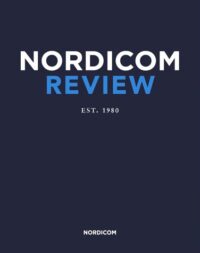In recent years, far-right movements have gained traction across Europe, and Scandinavia is no exception. At the same time, the public sphere has been reshaped by a hybrid media landscape that offers new opportunities for these political forces to grow and reach audiences.
Against this backdrop, Kari Steen-Johnsen and Audun Fladmoe from the Institute for Social Research in Norway, together with Karoline Andrea Ihlebæk from the Department of Journalism and Media Studies at Oslo Metropolitan University, set out to understand who turns to right-wing alternative media in Scandinavia and why.
Their article, recently published in Nordicom Review, offers a comparative look at Norway, Sweden, and Denmark to explore what characterises right-wing alternative media users in terms of political attitudes and political, media, and social trust.
Mapping a New Media Landscape
The researchers’ starting point was an observation: If the Nordic countries are so similar, with similar media systems, why does the market share of right-wing alternative media differ so much between them?
“The outreach of far-right alternative media outlets varied considerably across the three countries”, explains Fladmoe. “You have rather similar countries, rather similar media systems. But here we find something that differs, and we wanted to understand why”.
Their findings suggest that users of right-wing alternative media share a distinct profile. They are more likely to support far-right ideas and parties, and they show lower levels of trust – especially in media, but also in political institutions more broadly. “This is a distinct group in many respects, and within this group there’s a smaller segment that is more extreme and also less trusting”, Steen-Johnsen notes.
“Still, most of those who read alternative media are within the democratic community. They also read and are exposed to mainstream and public service broadcasters. These alternative outlets act as sources for far-right ideas, and the gaps they fill vary across the three countries”, she continues.
National Contrasts and a Danish Exception
Despite their similarities, the Scandinavian countries also show some differences. In Denmark, users of right-wing alternative media express relatively higher trust in traditional news outlets than their Swedish or Norwegian counterparts.
“It’s important to emphasise that general trust levels are not higher in Denmark”, says Fladmoe, “but that the alternative media users express higher trust in the traditional media here than in Norway and Sweden”.
The explanation, he suggests, lies in the media market. Danish mainstream journalism has been more willing to cover or debate issues that resonate with far-right audiences – especially scepticism toward immigration. “In Sweden, that has happened to a lesser extent”, he says. “So, there’s more room for alternative outlets to cater to those audiences”.
Steen-Johnsen adds that this aligns with comparative research indicating how national contexts matter. “If there’s a higher prevalence of alternative media in a country, you’ll also find a stronger association with far-right attitudes and populism, more like the Swedish case”, she notes.
A Question of Trust
The researchers also found a clear link between ideological attitudes and low trust in mainstream media. But which comes first? Do people with far-right ideas seek out alternative media, or does consumption of such outlets reinforce their distrust?
“This taps into a classical question in media studies”, says Steen-Johnsen. “Is it media effects or selective exposure? Do people seek what they want, or are they shaped by what they consume? Probably both, a reinforcing spiral”.
“One way to address this could be longitudinal research that follows individuals over time”, she says. “But it’s difficult to map what people are truly exposed to. Data-donation approaches or combined quantitative and qualitative methods might provide answers”.
Fladmoe suspects that selective exposure plays the stronger role. “If there were strong media effects, then Swedes should be much more inclined to support far-right ideas and have much lower media trust than the Danes”, he notes. “But that’s not the case, so that supports the idea of selective exposure”.
At the same time, he points out that the Nordic media systems are not as polarised as, for example, the United States. “We can’t really identify a pure alternative media user”, he says. “Almost all of them also consume traditional media. So, we don’t have the same kind of siloed media markets, and that, I guess, is a positive thing”.
Beyond the Right – Looking to the Left
Although the study focuses on right-wing audiences, the researchers point out that alternative media use also exists on the far left. Left-wing sites have for instance been concerned with alternative coverage of Covid and vaccines as well as the Russian invasion of Ukraine.
“It’s very important to follow developments on both sides,” Ihlebæk says. “In Norway, for instance, some far-left sites covered the war in Ukraine from a very different perspective than the mainstream media. What these far-right and far-left alternative media sites have in common is criticism of mainstream journalism’s claimed objectivity”.
Yet there are differences, Fladmoe notes. “People who support far-left parties in Scandinavia are much more likely to use national broadcasters”, he says. “So, a study of far-left users would probably find a smaller group and weaker media distrust, and perhaps more political distrust instead”.
How Should Mainstream Media Respond?
The researchers agree that distrust in traditional media remains the strongest driver of alternative media use. That places a challenge on the shoulders of established journalism.
“It’s something editors have to convince their readers of every day – that they should be trusted, that their news matters”, says Ihlebæk. “Some newsrooms have become more transparent about editorial choices, and many work actively to reach young or sceptical audiences”.
This may also be where the opportunity lies: “Alternative media readers are politically interested and tend to use many news sources. You have a core of very distrusting and ideologically motivated people, but also a much broader group that may be convinced”, Steen-Johnsen concludes.
Read more
Right-wing alternative media users in Scandinavia: A comparative study of ideological attitudes and (dis)trust

Photo: Adobe Stock